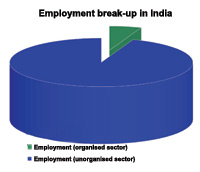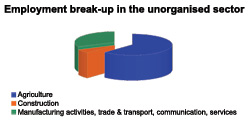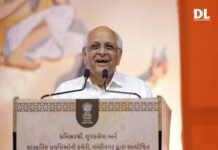To achieve targeted economic growth, India has to create skilled manpower of 500 million by 2020. With a deep focus on education in the XIth Five Year Plan, National Skill Development Mission has been launched under the guidance of the Prime Minister.
 India is one of the most progressive economies in the world. But the country still has many challenges and one of which is unemployment. One of the many reasons is a huge gap in proper skills development and vocational training to match up to the increasing pace of globalisation and technological changes taking place in the world. Countries with higher and better levels of skills adjust more effectively to the challenges and opportunities of globalisation and as India moves progressively towards becoming a 'Knowledge Economy' it becomes increasingly important that the focus on advancement of skills and these skills have to be relevant to the emerging economic environment.
India is one of the most progressive economies in the world. But the country still has many challenges and one of which is unemployment. One of the many reasons is a huge gap in proper skills development and vocational training to match up to the increasing pace of globalisation and technological changes taking place in the world. Countries with higher and better levels of skills adjust more effectively to the challenges and opportunities of globalisation and as India moves progressively towards becoming a 'Knowledge Economy' it becomes increasingly important that the focus on advancement of skills and these skills have to be relevant to the emerging economic environment.
 India has the biggest young population in the world and its median age in 2000 was less than 24 compared 38 for Europe, 30 for China and 41 for Japan. In the scenario, India has a unique opportunity because researches say that by 2020 an expected 25% of the population and 65% of the labour force will be in the age group of 15-29 years. It is also estimated that the ageing economy phenomenon will create a global shortage of skilled manpower of approximately, 56.5 million by 2020 where India will have a surplus of 42 million people of working age. Therefore, India has a wider opportunity over the ageing countries to cater to the shortage of labour population. Therefore, India needs to increase the skilled workforce from the current 5% to about 50% to meet up the huge gap.
India has the biggest young population in the world and its median age in 2000 was less than 24 compared 38 for Europe, 30 for China and 41 for Japan. In the scenario, India has a unique opportunity because researches say that by 2020 an expected 25% of the population and 65% of the labour force will be in the age group of 15-29 years. It is also estimated that the ageing economy phenomenon will create a global shortage of skilled manpower of approximately, 56.5 million by 2020 where India will have a surplus of 42 million people of working age. Therefore, India has a wider opportunity over the ageing countries to cater to the shortage of labour population. Therefore, India needs to increase the skilled workforce from the current 5% to about 50% to meet up the huge gap.
|
Incentives in education sector from Union Budget 2010-11 Measures to foster inclusive development:
Skill development
Education
|
Reason de facto
As per the survey carried out by the National Sample Survey Organisation in the year 2004-05, the total employment in the country was of 459 million. Out of this, about 26 million were in the organised sector and the balance 433 million in the unorganised sector and in that, 269 million workers were employed in agriculture sector, 26 million in nonagricultural sector. This huge unorganised sector which constitutes about 94% of the total workforce is not supported by any structural system of acquiring or upgrading skills.
Besides, of the total Indian industrial workforce only 5% is skilled as compared to the 85 % of the south east Asian countries. As the NSSO 61st Round results show that among persons of age 15






















